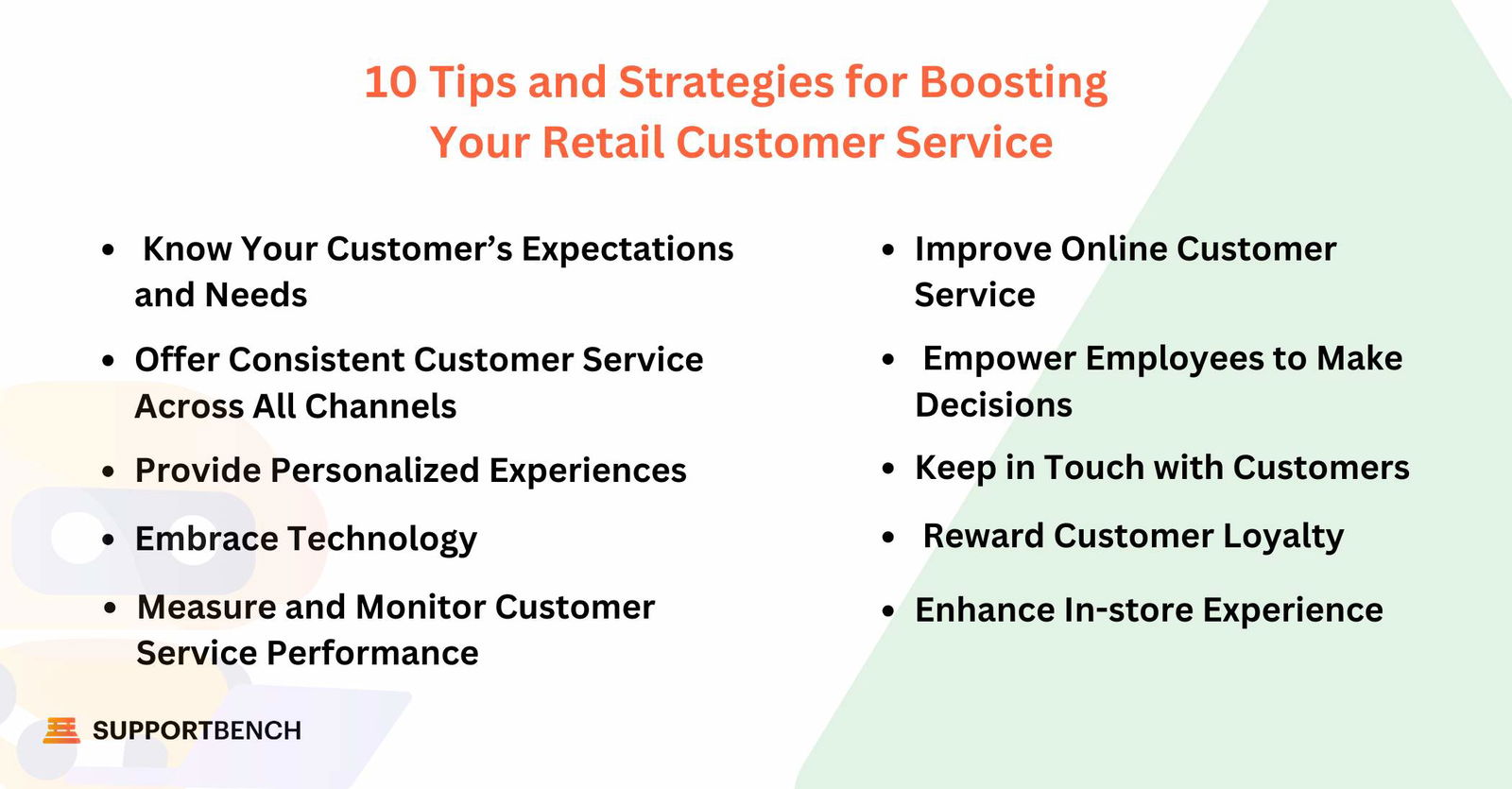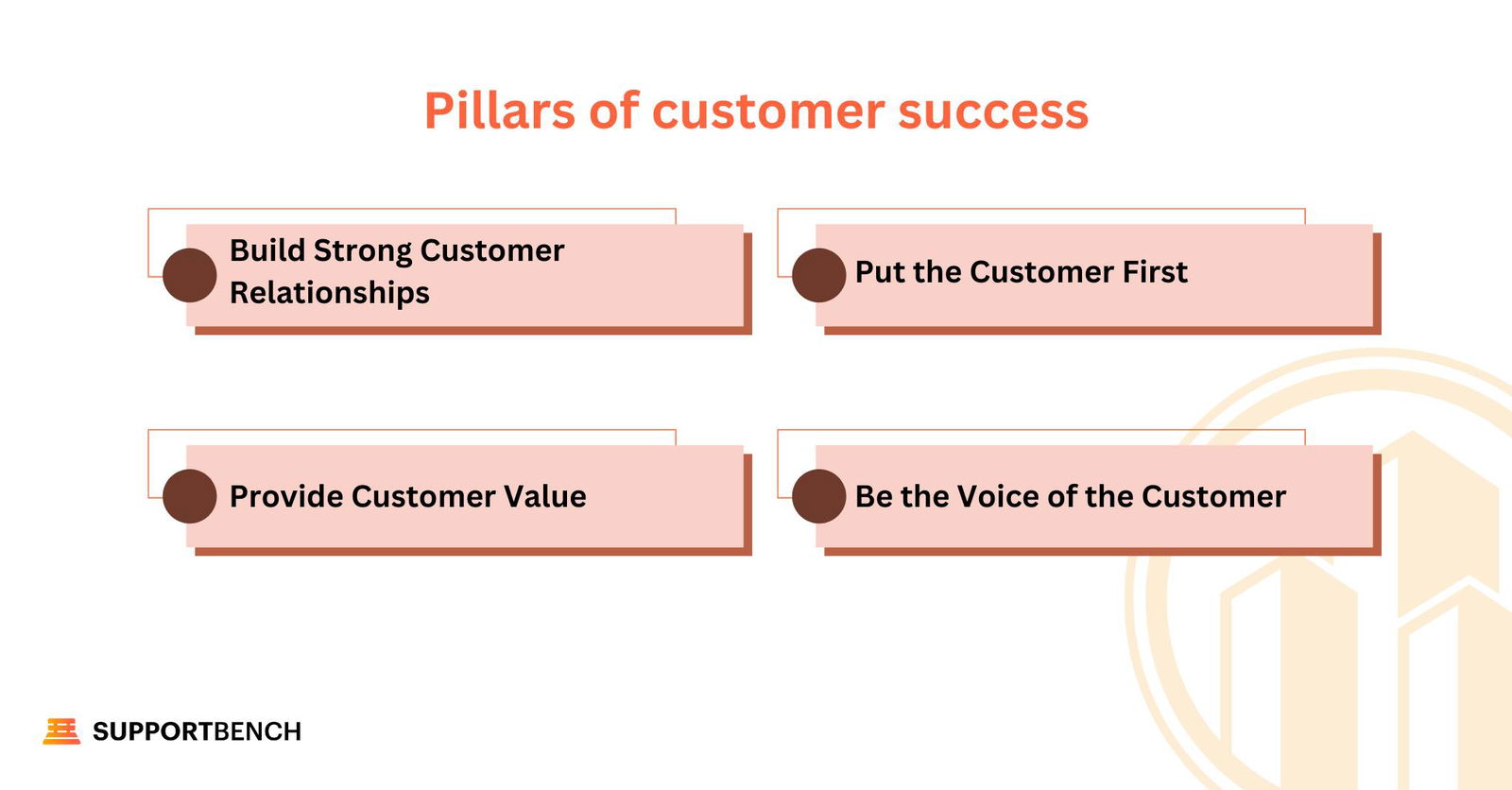Great customer service sets businesses apart. Companies that prioritize quick, helpful, and personalized support can foster strong customer relationships and loyalty. However, maintaining this level of service can be challenging, especially for businesses with complex products and multiple communication channels.
Supportbench provides a solution with its AI-driven platform, designed to streamline support operations and elevate customer experiences. With features like ticket management, workflow automation, customizable customer portals, and in-depth analytics, Supportbench empowers support teams to not only meet but exceed customer expectations, offering a competitive edge in the retail industry.
This ultimate guide to optimizing retail customer service explores strategies to help businesses stay aligned with evolving customer needs.
10 Tips and Strategies for Boosting Retail Customer Service
To deliver outstanding customer service in retail, consider these essential strategies:

Know Your Customer’s Expectations and Needs
Understanding what today’s shoppers expect is key to providing great customer service in retail. Modern consumers, influenced by major online retailers, social media, and a desire for personalized experiences, have rapidly evolving needs.
Retailers may find it challenging to meet these expectations consistently. To keep up, focus on providing seamless service across platforms, managing inventory effectively, and helping employees understand customer expectations.
Provide Personalized Experiences
Today’s consumers expect personalized interactions, and technology makes this easier and more affordable. Generative AI, for instance, enables highly customized customer interactions. Customers appreciate special offers, personalized emails, and product recommendations that align with their preferences.
Start by recognizing special dates like birthdays. Analyze customer data to identify preferred channels, relevant product recommendations, and tailored rewards, creating an individualized experience for each customer.
Offer Consistent Customer Service Across All Channels
Customers today prioritize convenience, often expecting proactive support across multiple channels, including social media, websites, email, and even audio or video calls. CRM systems and email marketing can boost personalization and engagement across these platforms.
If you’re a small business, focus on quality rather than quantity of channels. Prioritize high-quality service that prevents team overload. Technology, such as visual voicemail with transcripts, can also save time, enabling efficient customer support.

Embrace Technology
The right technology can significantly enhance customer service quality and efficiency, from smoother transactions to improved personalization.
Ways to leverage technology include:
- AI Chatbots: Provide instant assistance, answer common questions, and support online purchases.
- CRM Systems: Track customer behaviour and preferences, enabling a personalized shopping experience.
- Queue Management Software: Reduces wait times by managing foot traffic, enhancing the in-store experience.
Enhance In-store Experience
Is your store welcoming and easy to navigate? Optimize your layout, add interactive displays, and use clear signage. Ensure products are easy to find, use appealing visuals, and create smooth pathways.
In-store experiences are boosted by personalized assistance and efficient service, especially with quick payment options like self-checkout and mobile payment. Well-trained employees complete the experience, creating an environment that encourages customers to return.
Improve Online Customer Service
In today’s market, excellent online customer service is essential. Focus on creating a user-friendly website and mobile app with easy navigation, clear product descriptions, and high-quality images.
A smooth, secure checkout process is critical to reduce customer frustration. Offer fast, helpful support via live chat, email, or phone, and consider sharing a digital business card with contact details for key support staff. These steps can lead to higher satisfaction, trust, and loyalty.
Empower Employees to Make Decisions
Nothing frustrates customers more than hearing, “I’m sorry, there’s nothing I can do.” Empower front-line employees to make service decisions to enhance customer satisfaction quickly. This also boosts employee morale by giving them more control over positive interactions.
Keep in Touch with Customers
The adage “the customer is always right” still holds value. Regularly reaching out through surveys, social media, or even face-to-face focus groups can provide valuable insights.
Encourage customers to share feedback on review sites, and use this input to improve your services. Follow up with updates via email or other channels, keeping customers engaged and showing that their opinions are valued.

Reward Customer Loyalty
Once you’ve built customer loyalty, it’s crucial to recognize it. A robust loyalty program encourages repeat business by offering rewards for ongoing support. Paired with point-of-sale software, this approach enables a personalized experience both online and in-store.
Measure and Monitor Customer Service Performance
Tracking performance metrics, such as customer satisfaction, response times, and resolution rates, is vital. Encourage open feedback and use text analytics software to identify recurring issues or sentiments. This insight helps improve training, address problems, and celebrate achievements.
Measuring customer service is an ongoing effort that supports a positive environment for your team and loyal customers.
What are the 4 pillars of customer success?
An effective customer success strategy is built on four key pillars, each ensuring that clients gain maximum value from your product or service, which fosters loyalty and long-term relationships.

Build Strong Customer Relationships
Strong customer relationships are the foundation of customer success. This involves meaningful, regular communication that goes beyond problem-solving to truly understanding customers’ needs, goals, and challenges.
By engaging with customers in a respectful and empathetic manner, you build trust and loyalty. These strong relationships turn customers into brand advocates, promoting your business and contributing to customer retention and growth.
Put the Customer First
Putting the customer first means focusing on their needs at every stage of their journey. This includes actively listening to feedback, promptly addressing concerns, and demonstrating that customer satisfaction is a top priority.
A customer-focused approach enables your team to make decisions that enhance the customer experience, strengthen loyalty, and set your business apart. Prioritizing long-term customer needs over short-term gains drives lasting success.
Provide Customer Value
Delivering tangible value is essential for customers to recognize the importance of your product or service. Meeting immediate needs is only part of the equation—anticipating future needs and aligning with customers’ long-term goals are equally important.
By helping customers reach their objectives and solve challenges, you reinforce your relationship. Regular check-ins and proactive suggestions keep your product’s value at the forefront, ensuring customers remain engaged.
Be the Voice of the Customer
Being the voice of the customer involves advocating for their needs within your organization. Actively gather and share insights from customer feedback, usage patterns, and support interactions to enhance products and services.
By consistently representing customer views and conveying feedback to your teams, you integrate customer needs into every decision. This approach not only makes your product more relevant but also fosters a culture of continuous improvement, keeping your business aligned with customer priorities.
Conclusion
Optimizing retail customer service requires a focus on proactive support, seamless communication, and personalization at every stage of the customer journey. By implementing these strategies, businesses can boost customer satisfaction, foster loyalty, and gain a competitive advantage.
For a comprehensive solution that addresses these needs, consider Supportbench—a platform designed to transform customer support, streamline operations, and enhance the retail experience. Discover how Supportbench can help elevate your retail customer service to the next level.












